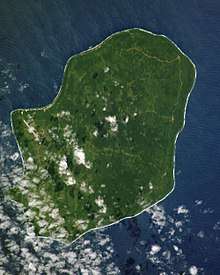Low island
A low island is, in geology (and sometimes in archaeology), an island of coral origin. The term applies whether the island was formed as a result of sedimentation upon a coral reef or of the uplifting of such islands. The term is used to distinguish such islands from high islands, whose origins are volcanic.[1]
Definition and location
This distinction is important to understand, as there are some low islands, such as Makatea, Nauru, Niue and Banaba, which rise several hundred feet above sea level, while a number of "High Islands" (those of volcanic origin) can rise no more than a few feet above sea level, often classified as "rocks". Low islands are the kind of islands which ring the lagoons of atolls.
The two types of islands are often found in proximity to each other. This is especially the case among the islands of the South Pacific Ocean, where low islands are found on the fringing reefs that surround most high islands.
Climate and general habitability
Low islands have poor, sandy soil and little fresh water, which makes them difficult to farm. They cannot support human habitation as well as high islands. The people that do live on low islands survive mostly by fishing. Low islands usually have an oceanic climate.
See also
References
- Raymond E. Murphy: "'High' and 'Low' Islands in the Eastern Carolines", Geographical Review, Vol. 39, No. 3, Jul., 1949. Retrieved 2011-09-22.
External links
- Micronesian culture: High island and low island cultures at Britannica.com. Retrieved 2011-09-22.
